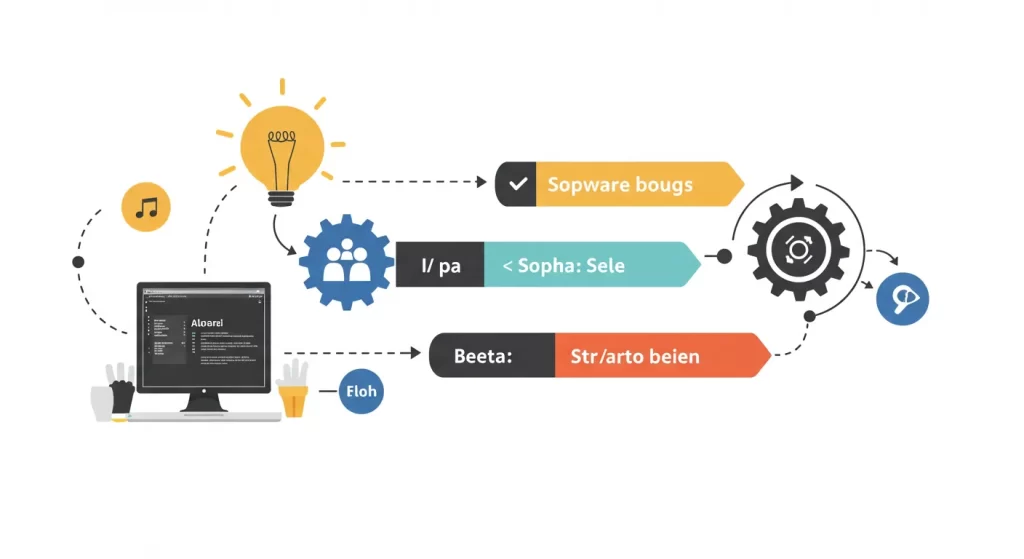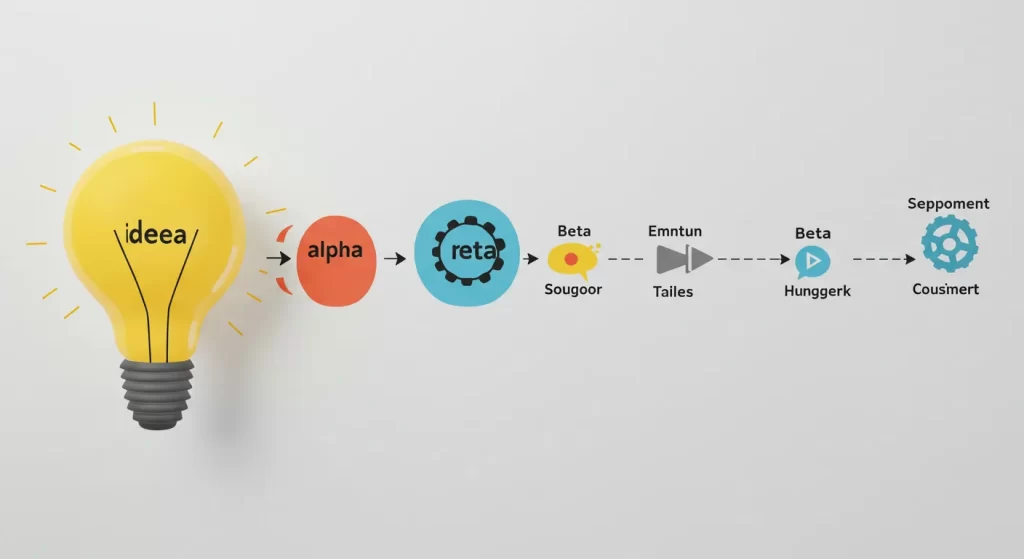Table of Contents
software development is tough work, and it can be easy to feel like you’re about to step onto a tightrope as you try to be the perfect version of the product. At the same time, companies want their products to be as seamless and streamlined as possible so they can make things as user-friendly as possible.
One of the most common types of Software Releases That Might Still Be Buggy comes in the form of an alpha or beta version, when the software is being developed and tested in conjunction with a limited number of users.
The way to make a buggy release work, especially as it gets shipped is by testing it out with other beta users. If you want to know more about how to make such a buggy software release work, read on.
The Development Journey: From Idea to Release
The process of software development starts with the idea that is going to be turned into something by developers and then there are various stages that go along with this like alpha and beta. It is when developers find bugs and get feedback on what ‘s not working yet but when the software is most likely going to be bugged.
At alpha stage the software is often very raw, un polished. Developers often take it in internally to make sure the most important features are running as expected. But alpha does not mean it ‘s stable – there will be issues.
Once it ‘s reached beta you can start looking for external testers to beta test the software out. ( Sometimes they release the beta version to the general public for testing in the real world ) While the software by beta stage is mostly finished it ‘s not complete and bugs may still come up as users interact with it.
Why Early Versions Are Bug-Prone

Why do some early software releases have bugs? You really don’t want to let people get greedy. I think the first big reason is that the development process is still inherently complex. Developers have to test things like different scenarios, edge cases and different systems. It makes a lot of variables in play that a bug could slip through the cracks. More About Here: Alternatives Plarforms
In addition, while the testing phases are thorough (by no means exhaustive), testing a piece of software in a controlled environment doesn’t necessarily indicate that it will be used in the real world. It might be possible to find bugs that were not found during internal test sequences that warrant additional patches and updates.
Also Read: Understanding Pirate Software Ego: A Comprehensive Guide
Common Types of Bugs in Early Software Releases That Might Still Be Buggy
Bugs in early software releases can be anything from minor inconveniences to major system failures. Here are the most common bugs you find in:
Performance problem The software might run slower than you expect or use more memory than it needs.
Interface problems: There could be errors in the graphical interface causing problems with navigation / accessing certain functions.
Compatibility Problems: Not all operating systems / hardware layouts will work well with the software.
Security Vulnerabilities Often early versions of software have flaws that could be exploited by hackers.
But then you have those bug that can be really annoying for the users because they ‘re part of the development process and usually have to be fixed in next release.
The Importance of Feedback in Early Releases
One of the primary benefits of releasing early versions of software is to garner feedback from actual users. Developers use feedback in large part to identify and fix bugs that may have been overlooked during internal testing. Feedback loop allows developers to continue testing the software and make sure it will work as expected when it ‘s ready for full release.
Some people are Beta testers for a reason. They can point out bugs and offer improvement to the developer to get those little things worked out. Sometimes it can be frustrating to be an early adopter of a product but you get your moneys worth for helping with the final release.
How Developers Manage Bugs in Early Software Releases

When new software version is released there are seemingly always bugs. However the developers have protocols and processes in place to track and address those bugs quickly. Common practices include the following:
Bug Tracking Systems: Bug Tracking Systems let developers log, prioritize, and track bugs that come up.
Frequent updates: after issues are discovered developers release regular patches/updates to fix the issues & improve performance.
User Support Many companies offer customer support to help users that find bugs in the software so they can continue using the software while the company fixes them.
How to Navigate Buggy Software Releases as a User
For uiers it can be tricky dealing with bugs in early releases but there are ways you can mitigate the process. Here are a few things to look out for
Be patient: Early releases are a work in progress and bugs are common during the development process.
Give feedback: If you find a bug in the software, let the developers know and their feedback will help refine the software.
Utilize workarounds Sometimes temporary solutions can ease you past bugs until a patch is released.
Updated Frequently Asked Questions: Software developers release updates to fix bugs. It ‘s important to keep software up to date to run smoothly.
Also Read: Upgrade Your Audio Experience with The Yeti Blue Software
Balancing Innovation and Stability
While it’s tempting to release software quickly to stay ahead of competitors, it’s important to balance innovation with stability. Sometimes, the desire to be the first to market can lead to buggy releases. However, too many bugs can damage a company’s reputation. A well-tested, stable release tends to build trust with users, while buggy versions might frustrate them.
The Role of Beta Testing in Quality Assurance
Beta Testing is a key piece of quality assurance before any kind of software releases. You get an idea how the software runs in various real world scenarios with the help of beta testers. Beta testers can identify bugs and usability issues that were not found during the earlier stages of testing. This is one of the most valuable things that developers can get before actually releasing their software.
Not All Bugs Are Created Equal

It ‘s also worth noting that not all bugs are equally bad – some may be minor and barely noticeable, while others can have major implications for game functionality. Software developers tend to prioritize patching more significant bugs that interfere with functionality over patching less significant bugs. So as a user it ‘s helpful to distinguish between annoying bugs that don ‘t interfere with the core functionality vs. ones that prevent you from using the software the right way.
Software Updates: The Key to Fixing Bugs
After the first release of a software product, the developers often update the product to fix bugs and improve the user experience. Most of the time, developers release updates as patches, which fixes bugs, fix security issues and sometimes add new features to the software. Very often, updates are required to keep the software performing well and correct any issues that users have encountered.
Embracing the Imperfections of Software Releases
Software Releases That Might Still Be Buggy are typically buggy, but these bugs are part of the software development process. Knowing that early software releases (aka alpha or beta) contain bugs makes it easier for users to be patient with these early software releases and to provide valuable feedback. Working together as developers and users, we can work toward ensuring that software products will improve over time – with a more polished end product.
Because software is in continual improvement it is probably safest to say that it is better to accept the early software versions and come with more stability down the road. Be aware of any changes, bug reports and enjoy the new features with every update.
FAQs
Why are early software releases buggy?
Early software versions are still under development and testing. Bugs arise due to incomplete features and real-world user scenarios that weren’t foreseen.
What is the difference between alpha and beta versions?
Alpha versions are early, internal tests, while beta versions are released to a wider audience for feedback. Beta versions usually have fewer bugs but aren’t fully stable.
How can I report bugs in beta software?
Most beta software has built-in feedback options. You can report bugs through the app or website, helping developers improve the product before full release.
Are all bugs fixed after the beta stage?
Not all bugs are fixed immediately. While beta testing uncovers many issues, developers release patches to address critical bugs after the official release.
How long does it take to fix bugs after a software release?
The time to fix bugs varies based on severity. Minor bugs may take weeks, while critical issues are addressed in patches or updates within days or hours.

